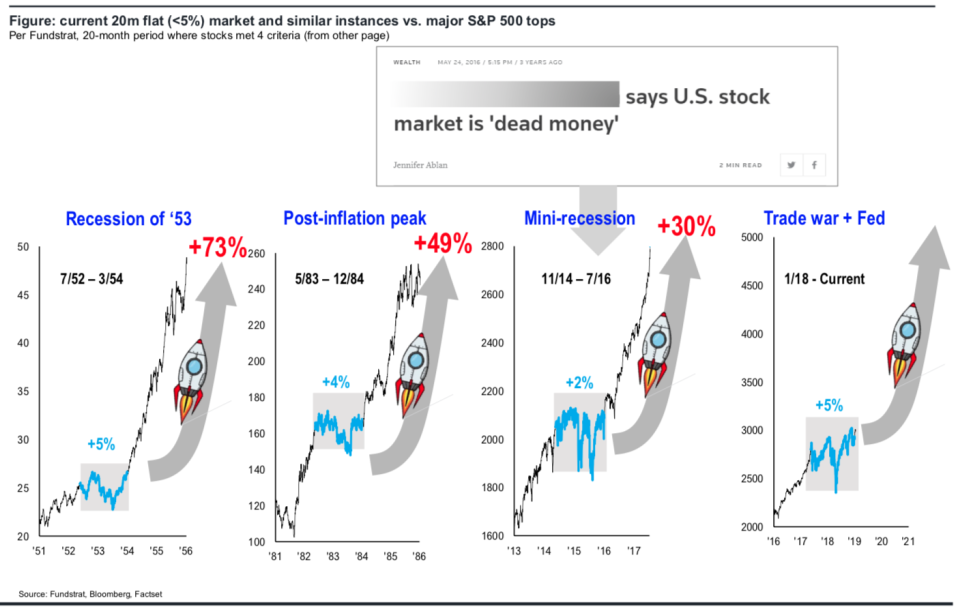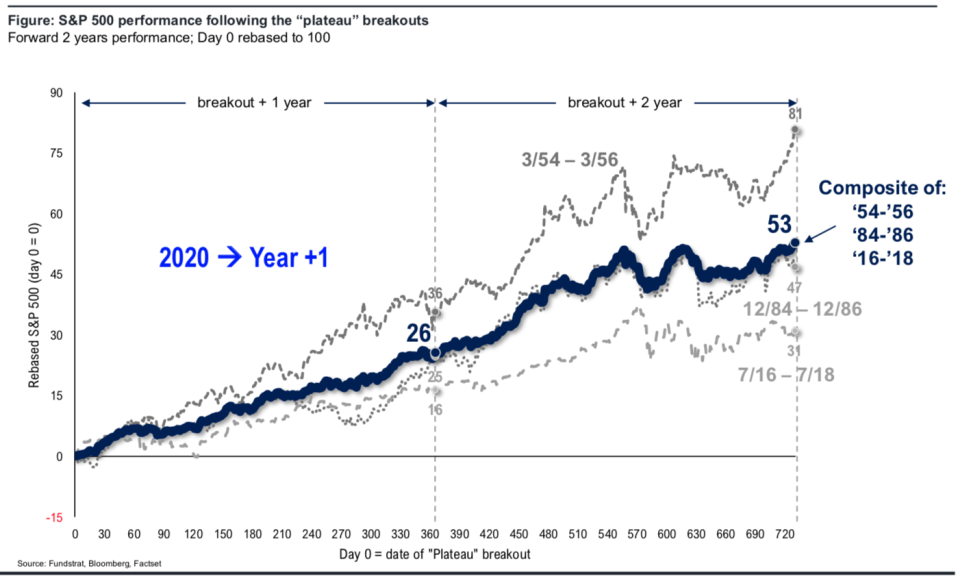Stocks are repeating an extremely bullish pattern: Morning Brief
Monday, December 23, 2019
Get the Morning Brief sent directly to your inbox every Monday to Friday by 6:30 a.m. ET. Subscribe
The last three times this happened, stocks rose at least 30%
Stocks finished the last full trading week of the year at record highs.
Since the most recent trough in the market hit back in early October, the S&P 500 is up 11% and the Dow has gained just under 9%.
This rally has certainly caught the attention of investors.
According to the American Association of Individual Investors, 44.1% of investors were feeling bullish for the week ended December 18, up 6.5 percentage points from the prior week and the highest reading of 2019. And a report from Bank of America Global Research earlier this week showed the firm’s clients were net buyers of stocks for the third week in a row.
The newfound enthusiasm for stocks into the end of the year will certainly make some observers nervous, as this bullishness will be seen as a contrarian indicator of what the future holds for this market.
But taking a step back from the market’s recent rally and investors concerned about the November-December push to record highs should find some relative comfort from market history. After all, a major theme earlier this year is that the market had “gone nowhere” for almost two years.
In a note to clients this week, Fundstrat’s Tom Lee highlighted periods similar to the flat, frustrating market of 2018-19. A period during which investors endured a nearly 20% decline while stocks gained a measly 5% during a 20-month period that saw corporate earnings rise in excess of 20%. (Of course, history also shows the market’s performance doesn’t always square with current-year earnings.)
Regular readers of Tom Lee’s work will not be surprised: history says this current set up is quite bullish.

Lee looked at periods from the 1950s, 1980s, and earlier in the 2010s and found that when the market goes up 5% or less over a 20-month period, returns in the two years ahead tend to be stellar. Taking a composite of these periods implies a 53% return for the S&P 500 over these periods that follow flat markets.
And this points towards returns that could top 25% for the S&P 500 in 2020. With 2020 potentially serving as the mere beginning of this new breakout rally.

Last week, we highlighted work from SunTrust’s Keith Lerner that showed strong markets often beget more strength in the year ahead.
Since World War II, the S&P 500 has gained more than 20% in a year 24 times; the following year, stocks finished higher 79% of the time (or 19 times) with the average gain totaling 13%. In 16 of those 19 years, the market gained double-digits.
And so this late-year breakout isn’t something history suggests is cause for concern.
By Myles Udland, reporter and co-anchor of The Final Round. Follow him @MylesUdland
What to watch today
Economy
8:30 a.m. ET: Durable goods orders, November preliminary (1.5% expected, 0.5% in October)
8:30 a.m. ET: Capital goods orders non-defense excluding aircraft, November preliminary (0.2% expected, 1.1% in October)
8:30 a.m. ET: Capital goods shipments non-defense excluding aircraft, November preliminary (0.0% expected, 0.8% in October)
8:30 a.m. ET: Chicago Federal Reserve National Activity Index, November (-0.31 expected, 0.71 in October)
8:30 a.m. ET: New home sales, November (730,000 expected, 733,000 in October)
From Yahoo Finance
Top News
Aramco stocks give up about half of gains since debut [Bloomberg]
China's industrial output to grow around 5.6% year-on-year in 2019: ministry [Bloomberg]
Why Disney's Bob Iger could face greater hurdles in 2020 [Yahoo Finance]
China to cut tariffs on pork, tech from list worth $389 billion [Bloomberg]
YAHOO FINANCE HIGHLIGHTS
The most-wanted sneakers of the decade: GOAT
How Mariah Carey still makes millions from her 1994 Christmas hit
Neil deGrasse Tyson: There's 1 big question surrounding commercial space travel
Follow Yahoo Finance on Twitter, Facebook, Instagram, Flipboard, SmartNews, LinkedIn, YouTube, and reddit.

